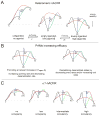Positive allosteric modulators as an approach to nicotinic acetylcholine receptor-targeted therapeutics: advantages and limitations
- PMID: 21575610
- PMCID: PMC3162128
- DOI: 10.1016/j.bcp.2011.05.001
Positive allosteric modulators as an approach to nicotinic acetylcholine receptor-targeted therapeutics: advantages and limitations
Abstract
Neuronal nicotinic acetylcholine receptors (nAChR), recognized targets for drug development in cognitive and neuro-degenerative disorders, are allosteric proteins with dynamic interconversions between multiple functional states. Activation of the nAChR ion channel is primarily controlled by the binding of ligands (agonists, partial agonists, competitive antagonists) at conventional agonist binding sites, but is also regulated in either negative or positive ways by the binding of ligands to other modulatory sites. In this review, we discuss models for the activation and desensitization of nAChR, and the discovery of multiple types of ligands that influence those processes in both heteromeric nAChR, such as the high-affinity nicotine receptors of the brain, and homomeric α7-type receptors. In recent years, α7 nAChRs have been identified as a potential target for therapeutic indications leading to the development of α7-selective agonists and partial agonists. However, unique properties of α7 nAChR, including low probability of channel opening and rapid desensitization, may limit the therapeutic usefulness of ligands binding exclusively to conventional agonist binding sites. New enthusiasm for the therapeutic targeting of α7 has come from the identification of α7-selective positive allosteric modulators (PAMs) that work effectively on the intrinsic factors that limit α7 ion channel activation. While these new drugs appear promising for therapeutic development, we also consider potential caveats and possible limitations for their use, including PAM-insensitive forms of desensitization and cytotoxicity issues.
Copyright © 2011 Elsevier Inc. All rights reserved.
Figures



References
-
- Gotti C, Clementi F, Fornari A, Gaimarri A, Guiducci S, Manfredi I, et al. Structural and functional diversity of native brain neuronal nicotinic receptors. Biochem Pharmacol. 2009;78:703–11. - PubMed
-
- Uteshev VV, Meyer EM, Papke RL. Activation and inhibition of native neuronal alpha-bungarotoxin-sensitive nicotinic ACh receptors. Brain Res. 2002;948:33–46. - PubMed
Publication types
MeSH terms
Substances
Grants and funding
LinkOut - more resources
Full Text Sources
Other Literature Sources
Molecular Biology Databases
Miscellaneous

